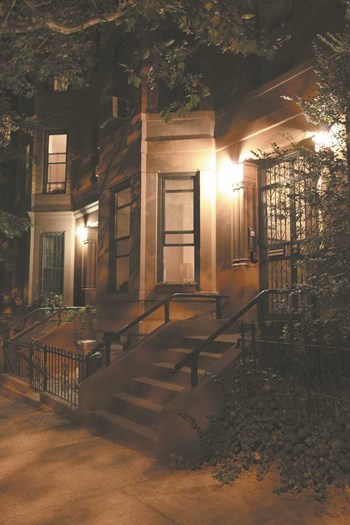
As the ubiquity of the condo “green” movement reaches even greater heights, many property managers find themselves searching for new ways to spruce up their operations. And with the continual advances in lighting technology—each more revolutionary than the next—it may well be time to look again at your property’s exterior lighting.
Common area lighting, understandably and unavoidably, will often comprise a large portion of a property’s energy budget. Yet experts say many options exist to lower your energy bottom line. And while some changes relate to the lighting technologies themselves, many others involve nothing more than adding new information to your management arsenal.
Use Common Sense with Lighting
“Good lighting decisions consist of three components,” says Dan Rozell of New York’s Department of Environmental Conservation. “Determine when lighting is necessary, choose the right fixture, and choose the right light source. Common sense dictates when lighting is necessary.”
Such common sense tactics, say experts, include reducing energy consumption and controlling light pollution—reducing the amount of wasted light. Yet lighting designers note that common sense is often unheeded in amateur lighting installations, as managers tend to over-light their condo properties—putting out more light than is necessary.
“People think that if they put twice as much light, it’s twice as safe or better—which is not true,” says Glenn Heinmiller, IALD, LEED AP, LC. As a principal at Lam Partners, an architectural lighting design firm in Cambridge, Massachusetts, Heinmiller works often with new condo construction, and sees the same mistakes made continually in associations of all types. “If you play music twice as loud, it doesn’t make the music any better. If you have a really nice dish at a fine restaurant, having twice as much food on the plate doesn’t make it taste any better. It’s the same with lighting. Once you achieve a certain level, having twice as much doesn’t get you anything—except wasted energy.”
Such problems point to the value of engaging professional lighting design experts when making any upgrades to existing condo lighting. But in cases where professional help is not an option, subtlety should be the watchword in the installation of any new fixtures. “Sometimes people feel like they’re doing the right thing by putting a big bright fixture on the side of the building,” says Heinmiller. “And it can actually make it harder to see. Because, if you stare at the fixture, you’re blinded by the fixture. Don’t over-light. And use fixtures that are shielded, directing the light only where it’s needed.”
“Good light fixtures generally point all their light downward where it will be used,” says Rozell. “Likewise, a good outdoor fixture is mounted low enough to prevent light from invading surrounding areas.” And this “invasion”—so-called “light trespass”—is a common cause of wasted energy on any condo property. “If you put light where you don’t need it, that’s just waste,” notes Heinmiller. “In any major city, if you look up into the sky, you really can’t see many stars. And the reason is that all this wasted light is bouncing off water vapor and particulates in the air. You want to restrict the amount of light that’s being wasted by going off into the sky or going into your neighbor’s bedroom window. And so a property manager should be looking at both those issues.”
When accessing those issues, say experts, among the first questions that will spring to a manager’s mind—or be foisted upon management by overanxious vendors—is the question of which new lighting technologies to embrace. And, on this point, consensus seems clear: LED lighting is the best, most durable and greenest option in exterior lighting today. But even the tersest examination of the subject reveals that all LED technologies are not created equal—a fact that may mean headaches when making lighting decisions. “I think that LED is all anybody’s talking about,” Heinmiller notes. “And I think for exterior lighting in a condo setting, LED is probably going to make a lot of sense.” But it’s a “buyer beware” market when it comes to LED lighting claims, and many unscrupulous sellers have recently entered the marketplace, hoping to cash in on the LED obsession. Many of the products being pushed don’t stand up to the often-spectacular claims of their manufacturers, and prudent managers should scrutinize LED options carefully.
Exaggerated Solar Claims
Solar is another area rife with confusing and exaggerated claims. And while solar power remains a “feel good” option for exterior lighting, experts say it rarely adds up from a practical, dollars-and-cents perspective. In the case of large-scale exterior lighting, the numbers show that solar only makes sense in places where outdoor lighting is needed far from the electrical grid. “There are solar-powered lights you could use in your parking lot —with a photovoltaic panel and a battery,” says Heinmiller. “But there would never be any reasonable payback.”
Yet, in spite of the math, many condo properties have been persuaded to install these costly solar units—often adding tens of thousands to the overall cost of parking illumination. “People do it, I think sometimes because it’s a showcase. ‘Oh, look! We’re green! We put a solar panel on the light pole in our parking lot,’ ” notes Heinmiller. “It really doesn’t make any sense when you’re near the electricity. It’s always going to be less expensive to power it off the grid. It you want to have renewable energy, it’s going to make more sense to put photovoltaic cells on your condo building and feed power back into the grid than it would to have a light in the parking lot with a solar panel on it.”
Regardless of the technology employed, a property’s parking lot may often be a place where the bulk of lighting dollars are spent. And concern over parking lot safety—from crime prevention to avoiding pedestrian hazards—is justifiable reason for managers and residents to demand a well-lighted space. “Parking lot lighting really helps to keep burglars from being in the dark and being under concealment,” notes Michelle Boykins of the National Crime Prevention Council. “Those common areas are some places where maybe a little bit more lighting could add to security and maybe help you build a safer condo community.”
Yet addressing such safety concerns is not always as simple as shedding light on the subject. “There’s true safety—you want to make sure you see the steps so you don’t fall,” says Heinmiller. “And then there’s perception of safety, which is feeling secure. And a lot of that is about personal comfort.” Such psychological concerns, and the accompanying variations in human perception, often present unique challenges for managers. When facing a dark parking lot—or any shadowy common area, for that matter—the natural temptation is to simply throw light at the problem. Yet, as Heinmiller notes, an over-lighted parking area can be every bit as dangerous as a shadowy one. “People say, ‘Oh, the parking lot is too dark.’ So they put a big [wall-mounted fixture] on the side of the building and blast light out into the parking lot to make it safe. In fact, all they’re doing is blinding people. You walk toward the building, you look into that wall fixture, and you’re blinded. So, if there is a mugger out there…”
As with many areas of condo management, a scrupulously-chosen vendor list may well be the key to a property’s ongoing success. It is, after all, such enigmatic elements as lighting design and landscape architecture that often solidify a potential unit owner’s all-important “first impression” of a potential new condo home. A careful examination of new technologies, and attention to well-planned lighting design, will often shed new light on a property’s bottom line—a fact both managers and boards can appreciate.
“I think property managers need to [be informed] because I’m sure they’re all being approached or they’re reading [books and articles] about LEDs and the latest things they need to make their properties green. Or they’re hearing certain things about solar. They can get in a lot of trouble if they don’t so their homework,” says Heinmiller. “But the good ones should do it. And take credit for it.”
Matthew Worley is a freelance writer and a frequent contributor to New England Condominium.






Leave a Comment